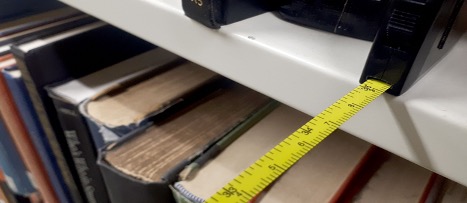Some Halifax students find Dalhousie’s main library hard to navigate
Killam Library acknowledges its stacks aren’t accessible to people with mobility concerns

caption
Some aisles in the Killam Library aren’t spaced to accommodate wheelchairs, making the space difficult to navigate.A Dalhousie student who uses a mobility aid finds navigating the upper floors of the Killam Memorial Library frustrating and, often, downright impossible.
Mary MacDonald has a physical disability and uses a motorized wheelchair known as a power chair in her daily life. She has been a student at Dalhousie University intermittently for over a decade. She says she’s frustrated with how the Killam library stacks are designed.
“I always need to bring an attendant with me when I go up there in the Killam,” MacDonald said. She added that Dalhousie’s largest library is poorly lit and that there is “nothing as challenging as the Killam.”
MacDonald can get through the aisles, but she says that’s not enough. She cannot turn around in the aisle with her chair and she says there is not enough space to see the books and journals on the lower shelves. She says she can move more easily at other libraries in the area, such as those at Mount Saint Vincent University and the University of King’s College, as well as at the Halifax Central Library.
MacDonald says that she got so frustrated the last time she visited the Killam that she just left without her materials.
The average width of a powerchair is between 66 and 81 centimetres. This creates a tight situation – literally. The clearance between bookshelves on the fourth floor of the Killam, where MacDonald does most of her research, ranges from 81 to 91 centimetres. This offers clearance for powerchair users about seven centimetres of space on either side in the best case and a complete barrier in the worst case.

caption
The aisle Mary McDonald does most of her research in is, at its widest, 88 centimetres across.Tracy Lenfesty, the head librarian at the University of King’s College library, explained that there are regulations about the distance between stacks in all libraries. “The minimum is 36 inches (91 centimeters); the ideal is 42 inches (106 centimeters),” she said. She acknowledged that, even at King’s, the shelves are too high for some wheelchair users but said staff are available to help.
The Killam also offers staff assistance in the stacks for users with mobility impairments, but MacDonald doesn’t think the retrieval service solves her problem. “What happens when students want to browse around? It makes the assumption that the students always know what they want,” she said.
Sarah Stevenson, the head of Killam and associate dean of archives, special collections, and record management, knows about the issues with accessibility in the stacks. “We are aware that our stacks are too narrow in places, and we have heard this from users before,” she said. She added that while she acknowledges it’s not a perfect solution, the book retrieval service is there to help students.
“When the Killam was built in the 1970s, accessibility was not a feature of the building plan,” Stevenson said. “As a result, we’re constantly adapting and improving the library, adding accessibility features as we go.”
The library has started updating the stacks with accessibility in mind. For example, the music room was renovated in the spring to ensure that shelves are now 106 centimeters apart to accommodate power chairs.
“We know that we need to reduce the number of stacks so that they can be spaced the appropriate distance to meet accessibility standards. We must also reduce the height of the stacks,” Stevenson said. Implementing all the necessary changes to make the stacks more accessible will be a long process, Stevenson added. The library’s print collection will have to be reduced or the building will have to be expanded.
Stevenson says the library has an obligation to reach the goals outlined by the Province of Nova Scotia’s Access by 2030 plan.
In 2021, Dalhousie released its accessibility plan to create more accessible on-campus spaces by 2030. Dal’s plan follows the provincial programs closely to develop more accessible buildings on campuses and renovate buildings to ensure accessibility and remove barriers to students.
About the author
Angela Capobianco
Angela Capobianco (she/her) is a Halifax-born journalist. She has a Master's degree in history from Queen's University and hopes to use her skills...
